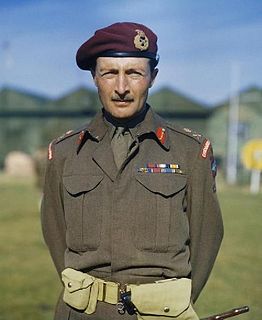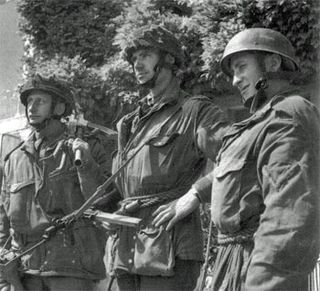
The XVIII Airborne Corps is a corps of the United States Army that has been in existence since 1942 and saw extensive service during World War II. The corps is designed for rapid deployment anywhere in the world and is referred to as "America's Contingency Corps". Its headquarters are at Fort Bragg, North Carolina.

Operation Tonga was the codename given to the airborne operation undertaken by the British 6th Airborne Division between 5 June and 7 June 1944 as a part of Operation Overlord and the D-Day landings during World War II.

The 1st Airborne Division was an airborne infantry division of the British Army during the Second World War. The division was formed in late 1941 during World War II, after the British Prime Minister, Winston Churchill, demanded an airborne force, and was initially under command of Major-General Frederick A. M. Browning. The division was one of two airborne divisions raised by the British Army during the war, with the other being the 6th Airborne Division, created in May 1943, using former units of the 1st Airborne Division.

Lieutenant-General Sir Frederick Arthur Montague "Boy" Browning, was a senior officer of the British Army who has been called the "father of the British airborne forces". He was the commander of I Airborne Corps and deputy commander of First Allied Airborne Army during Operation Market Garden in September 1944. During the planning for this operation, he memorably said: "I think we might be going a bridge too far." He was also an Olympic bobsleigh competitor, and the husband of author Dame Daphne du Maurier.

The 17th Airborne Division was an airborne infantry division of the United States Army during World War II, commanded by Major General William M. Miley.

The 6th Airborne Division was an airborne infantry division of the British Army during the Second World War. Despite its name, the 6th was actually the second of two airborne divisions raised by the British Army during the war, the other being the 1st Airborne Division. The 6th Airborne Division was formed in the Second World War, in mid-1943, and was commanded by Major-General Richard N. Gale. The division consisted of the 3rd and 5th Parachute Brigades along with the 6th Airlanding Brigade and supporting units.

Operation Varsity was a successful airborne forces operation launched by Allied troops that took place toward the end of World War II. Involving more than 16,000 paratroopers and several thousand aircraft, it was the largest airborne operation in history to be conducted on a single day and in one location.

General Sir Richard Nelson "Windy" Gale, was a senior officer in the British Army who served in both world wars. In the First World War he was awarded the Military Cross in 1918 whilst serving as a junior officer in the Machine Gun Corps. During the Second World War he served with 1st Parachute Brigade and then the 6th Airborne Division during the D-Day landings and Operation Tonga in 1944. After the end of the conflict, Gale remained in the army and eventually, in 1958, succeeded Field Marshal The Viscount Montgomery as Deputy Supreme Allied Commander Europe.

The First Allied Airborne Army was an Allied formation formed on 2 August 1944 by the order of General Dwight D. Eisenhower, the Supreme Allied Commander of the Allied Expeditionary Force. The formation was part of the Allied Expeditionary Force and controlled all Allied airborne forces in Western Europe from August 1944 to May 1945. These included the U.S. IX Troop Carrier Command, the U.S. XVIII Airborne Corps, which controlled the 17th, 82nd and 101st Airborne Divisions and a number of independent airborne units, all British airborne forces including the 1st and 6th Airborne Divisions plus the Polish 1st Parachute Brigade.

The German 1st Parachute Army was formed in September, 1944, comprising 30,000 men.

The 5th Parachute Brigade was an airborne forces formation of brigade strength, raised by the British Army during the Second World War. Created during 1943, the brigade was assigned to the 6th Airborne Division, serving alongside the 3rd Parachute Brigade and the 6th Airlanding Brigade.

The 1st Parachute Brigade was an airborne forces brigade formed by the British Army during the Second World War. As its name indicates, the unit was the first parachute infantry brigade formation in the British Army.

The 2nd Parachute Brigade was an airborne forces brigade formed by the British Army during the Second World War.

The 3rd Parachute Brigade was an airborne forces brigade raised by the British Army during the Second World War. The brigade was initially part of the 1st Airborne Division, but remained in Britain when that division was sent overseas, and became part of the 6th Airborne Division, alongside 5th Parachute Brigade and 6th Airlanding Brigade.

The 6th Airlanding Brigade was an airborne infantry brigade of the British Army during the Second World War. Created during May 1943, the brigade was composed of three glider infantry battalions and supporting units, and was assigned to the 6th Airborne Division, alongside the 3rd and 5th Parachute Brigades.

In Operation Doomsday, the British 1st Airborne Division acted as a police and military force during the Allied occupation of Norway in May 1945, immediately after the victory in Europe during the Second World War. The division maintained law and order until the arrival of the remainder of Force 134, the occupation force. During its time in Norway, the division was tasked with supervising the surrender of the German forces in Norway, as well as preventing the sabotage of vital military and civilian facilities.

Brigadier Stanley James Ledger Hill, was a British Army officer, who served as commander of the 3rd Parachute Brigade, part of the 6th Airborne Division, during the Second World War. Born in Bath, Somerset, Hill was educated at Marlborough College and the Royal Military College, Sandhurst before joining the British Army in 1931 and being commissioned into the Royal Fusiliers. He commanded a platoon for a short period, and was then attached to the command post of Field Marshal Lord Gort during the Battle of France in May 1940, where he oversaw the evacuation of Brussels as well as the beach at De Panne during the evacuation of Dunkirk. After a brief period of time in the Irish Free State, he volunteered for parachute training and joined the 1st Parachute Battalion, and was its commanding officer when its parent formation, the 1st Parachute Brigade, was deployed to North Africa.

The British airborne operations in North Africa were conducted by British paratroopers of the 1st Parachute Brigade, commanded by Brigadier Edwin Flavell, as part of the Tunisian Campaign of World War II, over the period between November 1942 and April 1943.

The 6th Airborne Division advance to the River Seine occurred in August 1944, in the later stages of the Battle of Normandy, following the German Army's defeat in the Falaise Pocket, during the Second World War.

The 6th Parachute Battalion was an airborne infantry battalion of the Parachute Regiment raised by the British Army during the Second World War.



















